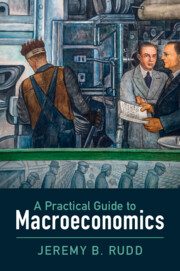Refine search
Actions for selected content:
76 results
16 - The Sixties
-
- Book:
- James Meade
- Published online:
- 27 December 2025
- Print publication:
- 31 January 2026, pp 580-610
-
- Chapter
- Export citation
Quantifying economic policy: Unsupervised learning on archival evidence from the United Kingdom, 1983–2021
-
- Journal:
- European Journal of Political Research / Volume 63 / Issue 2 / May 2024
- Published online by Cambridge University Press:
- 01 January 2026, pp. 750-773
-
- Article
-
- You have access
- Open access
- HTML
- Export citation
2 - Politics of Growth and Distribution
- from Part I - Politics at the Apex
-
- Book:
- Democracy and Inequality in India
- Published online:
- 11 October 2025
- Print publication:
- 30 October 2025, pp 64-92
-
- Chapter
- Export citation
9 - Authority Maintained
-
- Book:
- The City's Defense
- Published online:
- 09 October 2025
- Print publication:
- 23 October 2025, pp 326-343
-
- Chapter
- Export citation
Unequal outcomes in unequal times: the distributional consequences of Turkey’s unorthodox policies
-
- Journal:
- New Perspectives on Turkey / Volume 73 / November 2025
- Published online by Cambridge University Press:
- 06 October 2025, pp. 32-51
-
- Article
-
- You have access
- Open access
- HTML
- Export citation
The Nazi Financial Order: Banking Law and the Credit Supervisory Office in Germany and Austria
-
- Journal:
- Central European History , First View
- Published online by Cambridge University Press:
- 05 September 2025, pp. 1-27
-
- Article
-
- You have access
- Open access
- HTML
- Export citation
7 - The Economics of Climate Change
-
- Book:
- From Crisis to Action
- Published online:
- 15 August 2025
- Print publication:
- 04 September 2025, pp 143-175
-
- Chapter
-
- You have access
- Open access
- HTML
- Export citation
Macroeconomic populism in Chile: Allende and the recession of 1973
-
- Journal:
- Revista de Historia Economica - Journal of Iberian and Latin American Economic History / Volume 43 / Issue 2 / September 2025
- Published online by Cambridge University Press:
- 06 August 2025, pp. 309-332
- Print publication:
- September 2025
-
- Article
- Export citation
5 - The Three-Way Tussle for Food
-
- Book:
- Grains of Conflict
- Published online:
- 23 August 2025
- Print publication:
- 31 July 2025, pp 184-224
-
- Chapter
- Export citation
10 - Looking Ahead
-
- Book:
- The Great Disruption
- Published online:
- 05 June 2025
- Print publication:
- 19 June 2025, pp 253-260
-
- Chapter
- Export citation
Looking towards the sweet, sweet future: a political economy analysis of sugar and nutrition policy in Indonesia
-
- Journal:
- Public Health Nutrition / Volume 28 / Issue 1 / 2026
- Published online by Cambridge University Press:
- 17 June 2025, e112
-
- Article
-
- You have access
- Open access
- HTML
- Export citation
4 - Compromises, Procedures, and the Costs of Failure
- from Part II - Negotiating and Designing Economic Governance
-
- Book:
- Balancing Pressures
- Published online:
- 02 May 2025
- Print publication:
- 22 May 2025, pp 69-94
-
- Chapter
- Export citation
9 - Effectiveness, Fairness, and Responsiveness
- from Part III - Implementing Economic Governance
-
- Book:
- Balancing Pressures
- Published online:
- 02 May 2025
- Print publication:
- 22 May 2025, pp 212-233
-
- Chapter
- Export citation
1 - Governing the European Economy as Balancing Pressures
-
- Book:
- Balancing Pressures
- Published online:
- 02 May 2025
- Print publication:
- 22 May 2025, pp 1-22
-
- Chapter
- Export citation

Agent-based Macroeconomics
- The Schumpeter Meeting Keynes Models
-
- Published online:
- 02 May 2025
- Print publication:
- 29 May 2025
-
- Element
- Export citation
Case Study 5.1 - Sovereign Debt Restructuring in Zambia
- from Section 5 - Finance
-
-
- Book:
- A Casebook on Chinese Outbound Investment
- Published online:
- 28 February 2025
- Print publication:
- 06 March 2025, pp 235-247
-
- Chapter
-
- You have access
- Open access
- HTML
- Export citation
1 - Introduction
-
- Book:
- Artificial Intelligence
- Published online:
- 23 May 2024
- Print publication:
- 30 May 2024, pp 1-21
-
- Chapter
- Export citation
III - Economic Policies
-
- Book:
- Australia in World Affairs 1961–1965
- Published online:
- 29 March 2024, pp 182-233
-
- Chapter
- Export citation
IV - Economic Policies
-
- Book:
- Australia in World Affairs 1950–1955
- Published online:
- 29 March 2024, pp 125-148
-
- Chapter
- Export citation

A Practical Guide to Macroeconomics
-
- Published online:
- 28 March 2024
- Print publication:
- 04 April 2024
